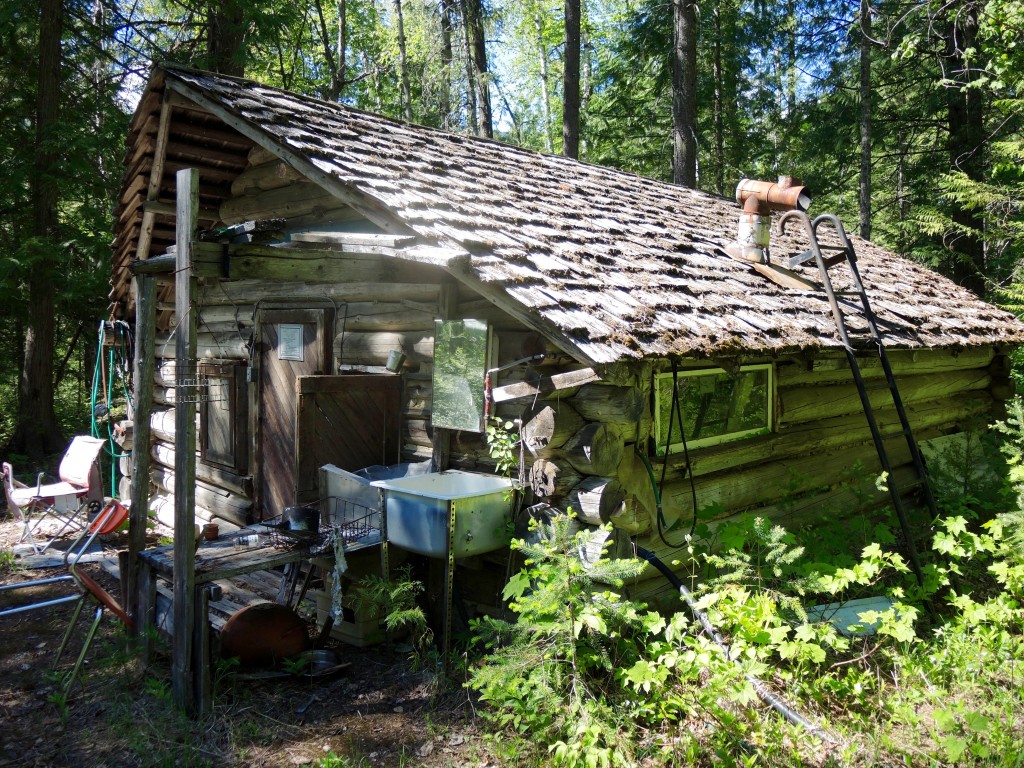The forest service burned down all the old cabins form the 1930s except this one, which was last used by a prospector in the 1990s.
The dream of striking it rich in the Scotch Creek valley attracted the interest of more than one eccentric prospector. Records indicate that in addition to Billy Henstridge, George Bourgeois and the short-lived placer mine operation, there were other leases in the 1930s and 40s. The list includes Mr. Greenwood and Henry Danroth, Charlie Johnson, Les Carson, F.W. Redforn, Cyrus Flanders, Bob Bristow and the original bushman of the Shuswap, Bunny (Theodor) Bischoff.
Judging from the stories about Bunny, he could easily be called a local legend. When Henry and Maria arrived in Scotch Creek from Minnesota with their five sons and three daughters in 1895, they became the first Caucasian family to settle in the North Shuswap. As the First World War began, Bunny and his brothers Pat, Matt and Cook headed for the hills to avoid conscription. Those years of living off the land and roaming by foot across alpine plateaus to as far away as Logan Lake, likely influenced Bunny to carry on this lifestyle for most of his years.
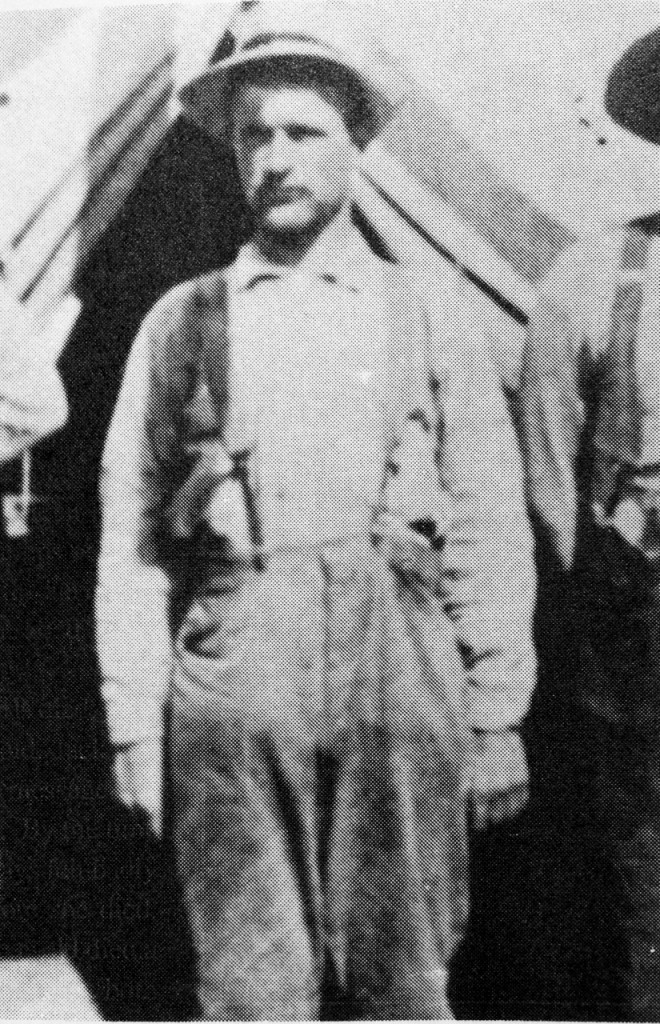 Bunny Bischoff, photo by Fred Bischoff, courtesy of North Shuswap Historical Society from Shuswap Chronicles, Volume 5
Bunny Bischoff, photo by Fred Bischoff, courtesy of North Shuswap Historical Society from Shuswap Chronicles, Volume 5
While his brothers took up homesteads above Celista, Bunny tried farming but opted instead for trapping and prospecting. He never had a regular job and perhaps he was more comfortable alone in the bush, where no one could hear his stuttering. His lease at Scotch Creek was located just east of the north fork above the falls and the 1936 Report of the Minister of Mines noted a small amount of hand work had been done 100 feet above the creek and recovery was not known.
Bunny also had a silver and zinc mining claim on the Adams Plateau called Mosquito King and he built a nearby log cabin. In recognition of the time that Bunny spent on the Adams plateau, a chain of lakes was named after him and his brother Pat, who was also a trapper. Ralph Bischoff recalls a story told by Lester Bentley who was logging up in the plateau during the winter and saw smoke coming out of a clump of balsam. He went over to investigate and found Bunny calmly making tea in a hole in the 13-foot deep snowpack, while taking a break from surveying lines on his claim.
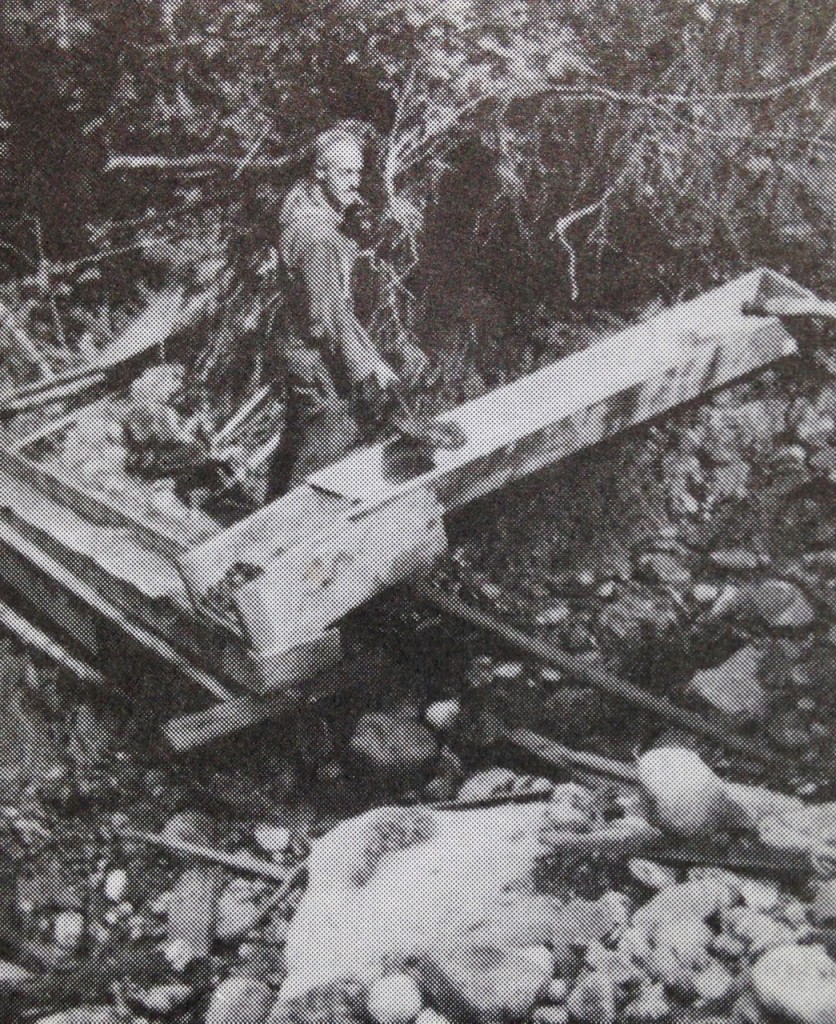 Bob Bristow at his sluice box, courtesy of North Shuswap Historical Society from Shuswap Chronicles, Volume 6
Bob Bristow at his sluice box, courtesy of North Shuswap Historical Society from Shuswap Chronicles, Volume 6
The most successful, independent miner in the Scotch Creek valley during the third gold rush was Bob Bristow, who arrived in 1931 and staked two leases on both sides of the forks. He accessed the area via a trail from Meadow Creek that was laid out by Henry Wallensteen, a Dominion forester. This trail carried on to the Adams Plateau, where Henry had a trapline and all the way to Adams Lake. In 1935, the Salmon Arm Observer reported that Bristow had found a gold nugget that weighed over half an ounce.
Bristow worked his claims for two years and then purchased Johnson’s claim, after he had a falling out with his partner Carson. After the Scotch Creek Placer Mines folded in 1938, Cyrus Flanders joined him as a partner. They installed a cable car across the creek to access their claim during high water using the cables left by the defunct placer mine. In order for his wife and young son to join him, Bristow also built a two-story log home above the creek.
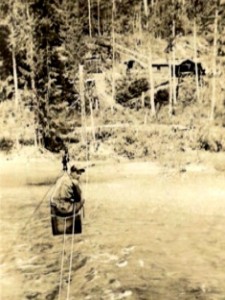 Bob Bristow riding his cable car across Scotch Creek
Bob Bristow riding his cable car across Scotch Creek
By 1941, Bristow was finished with gold mining likely due to diminishing recovery. He went to work for the Brown and Smith Store and eventually opened his own, Bob’s Supermarket, which was a fixture in Celista for many years. Another company, the Kywati Syndicate, moved into the valley and built two miles of flume from Garnet Creek. This effort was short-lived, as the government shut down all the placer mines the following year to focus on the war effort.
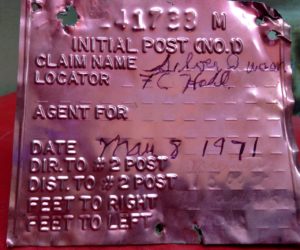 Frank Hall’s claim marker found near Scotch Creek
Frank Hall’s claim marker found near Scotch Creek
In the early 1970s, another eccentric old-timer, Frank Hall, sold his farm in Pritchard and moved to Meadow Creek to take up prospecting. Long time Lee Creek resident, Barrie Warkentin had also recently moved to an old nearby homestead as a greenhorn, back-to-the-lander. When Frank offered him employment for $5 a day and half the gold, he jumped at the opportunity. Barry remembers how they staked much of the area, busted up rocks, and dug trenches to bring water to a sluice box. While they rarely found any gold, Barry was always successful catching trout for their lunches!
Some prospecting along the creek continues to this day, as there are still active claims. Fortunately, no one ever attempted to divert the entire creek to search for gold as was suggested in the 1934 Minister of Mines Report. One day, the creek could produce some tourism gold, if trails could be opened to allow hikers to explore the region’s heritage and try their luck with a gold pan.
POSTSCRIPT
The R. J. Haney Heritage Village and Museum exhibit, “Can you dig it – Shuswap Mining History,” opens on July 8th and includes Chinese artifacts found in the Scotch Creek valley, old prospecting equipment, rock samples, maps and a gold nugget. Do check it out!
